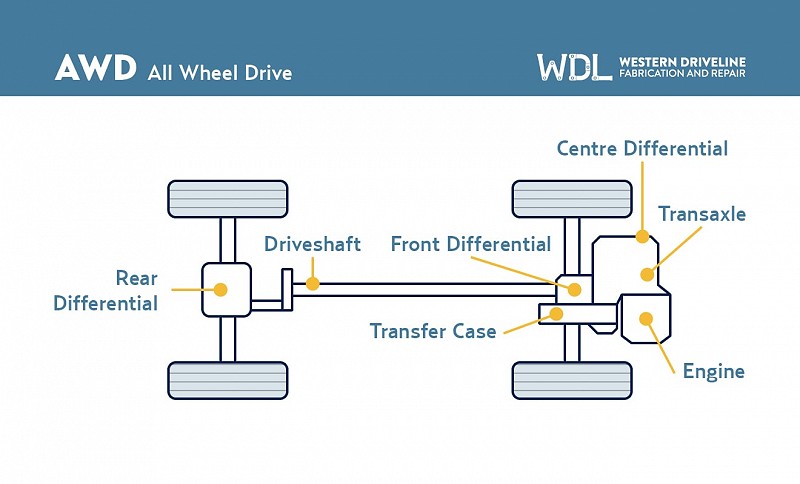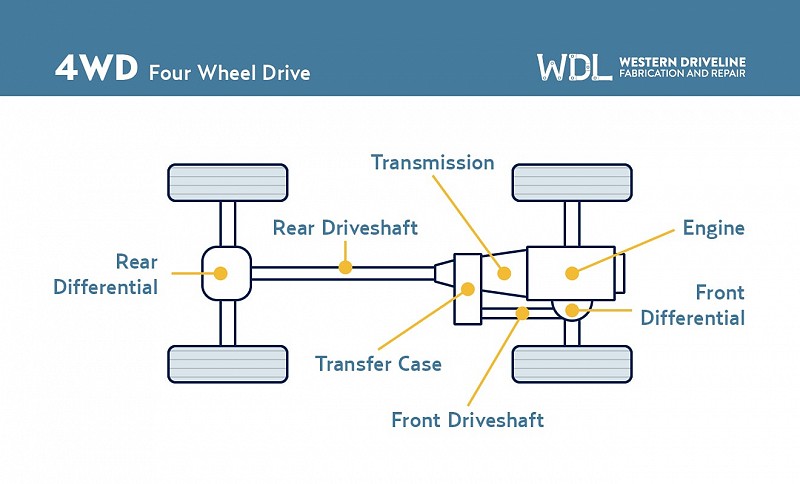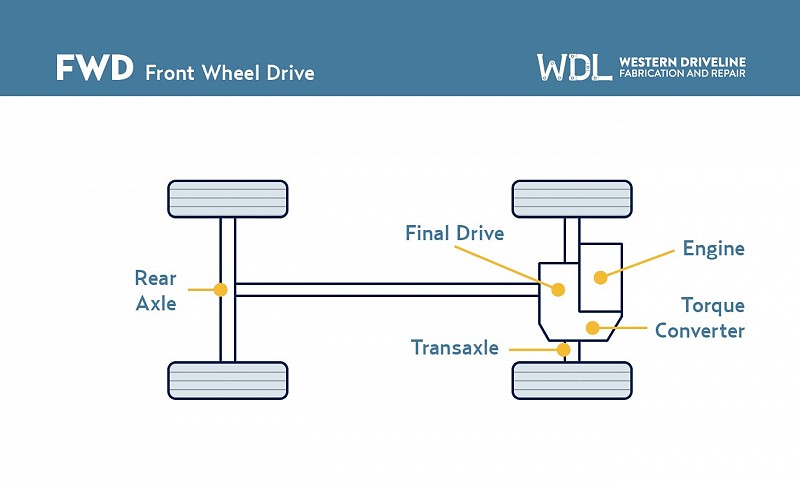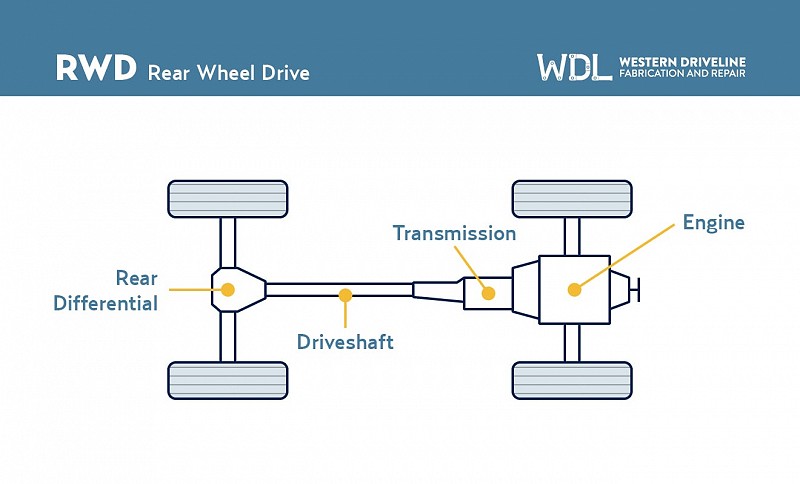Driveline Terms
Driveline terminology can be confusing even to those in the industry. If you’re having trouble telling a U-joint from a U-bolt, our driveline glossary should clear things up.

All-Wheel Drive (AWD)
All-wheel drive (AWD) vehicles have two driveshafts that help distribute power to all four wheels. One of these driveshafts is located at the rear, similar to a rear-wheel drive vehicle. The other driveshaft is located at the front and helps distribute power to the front wheels. The front driveshaft is connected to both the front differential and the transfer case using universal joints.

Four-Wheel Drive (4WD)
Most four-wheel drive vehicles have two driveshafts. Just like a rear-wheel drive vehicle, they have the rear driveshaft. However, they also have an additional front driveshaft that helps distribute power to the front wheels. This front driveshaft is connected with universal joints to both the front differential and the transfer case.

Front-Wheel Drive (FWD)
In a front-wheel drive vehicle, the power is delivered to the front wheels. This type of vehicle has a different setup compared to a rear-wheel drive vehicle. The drivetrain components are located at the front of the vehicle, so there is no need for a long driveshaft. Instead, this type of vehicle uses special joints called constant velocity (CV) joints to connect the components.

Rear-Wheel Drive (RWD)
In a rear-wheel drive vehicle, the power flows to the rear wheels, which are connected to the transmission by a long driveshaft. The driveshaft is connected at both ends with the help of universal joints, one to the transmission and the other to the differential.
A-to-Z List of Driveline Terms & Definitions
- Bearing
Bearings are mechanical devices that support another and/or reduce friction between another part. For example, center bearings connect the front and rear driveshafts in drivetrains typically found in rear wheel drive and 4×4 vehicles.
- Bearing Strap Kits
Bearing strap kits are a style of bracket used to secure a cross piece to a driveshaft yoke. A bearing strap fits around a bearing cap, and use bolts to secure it to the yoke. The holes in a compatible yoke are threaded to accept a bearing strap kit bolt, whereas they are unthreaded (smooth thru hole) to accept U-bolts.
- Center Support Bearing
The center support bearing is a rolling bearing element surrounded by rubber and mounted in a bracket configuration. Center support bearings are used to mount the support to an outside structure. Also known as: steady bearings, carrier bearings, and hanger bearings.
- Constant-Velocity Joint
CV joints allow a driveshaft to transmit power through a variable angle, at constant rotational speed, without an appreciable increase in friction or play. Commonly used in front wheel drive vehicles and in some modern rear wheel drive vehicles with independent rear suspension.
- Conversion Universal Joint
Conversion U-joints are very similar to normal universal joints, but are used when you want to connect two different driveshaft series together in one vehicle.
- Double-Cardan Driveshaft
The double-Cardan driveshaft configuration incorporates a double Cardan joint, where two U-joints are joined such that the second U-joint is phased in relation to the first to cancel the changing angular velocity. Generally classified as a CV joint, though not technically constant velocity. Commonly used to connect a transmission or transfer case to a rear or front axle.
- Driveline/Driveshaft
A driveline refers to an assembly built from a tubular or solid driveshaft connected by one or more universal joints. A driveshaft transmits mechanical power, torque, and rotation, in a fixed or variable angle from one shaft to another. Driveshafts are used to connect other components of a drivetrain that cannot be connected directly (because of distance or the need to allow for movement between them), typically through one or more universal joints. Also know as a Cardan shaft or propeller shaft.
- Half Rounds & Full Rounds
These terms are found when discussing yokes and universal joints. In half-rounds, the U-joint connects to its matching yoke using either a bearing strap kit or U-bolt, instead of being pressed into the yoke ears like on full rounds.
- Power Take-off
A power take-off (PTO) is a driveshaft, most commonly splined, typically installed on a tractor or truck allowing implements with mating fittings to be powered directly by the engine. PTOs may also be found on industrial and marine engines.
- Stub Shaft
There are two different types of stub shafts: a slip stub shaft gets welded onto the end of a driveline for a slip yoke to mate up to. A midship stub shaft has an area prepped for receiving a center support bearing to connect a two-piece driveshaft, and usually accepts an end yoke.
- U-Bolt
A clamping bolt with two parallel threaded legs used to retain a round bearing in certain end yoke designs. U-bolts look like a horseshoe in shape. The holes in a compatible yoke are unthreaded (smooth thru hole) to accept a U-bolt, whereas they are threaded to accept a bearing strap kit bolt.
- Universal Joint
Universal joints are × or + shaped parts that allow a vehicle’s rigid driveshaft to connect to the transmission or differentials and rotate freely. Universal joints are typically made of steel, with a bearing cap at each end. Also known as a universal coupling, U-joint, Cardan joint, Spicer or Hardy Spicer joint, or Hooke's joint. Even in a double-Cardan setup, a U-joint is not a constant-velocity (CV) joint.
- Yoke
Yokes unite, couple, or connect components. In a driveshaft, yokes couple with universal joints to connect with another driveline component. Slip yokes, end yokes, weld yokes, flange yokes are all different styles of yokes used in drivetrains.

